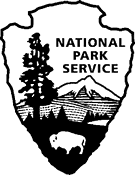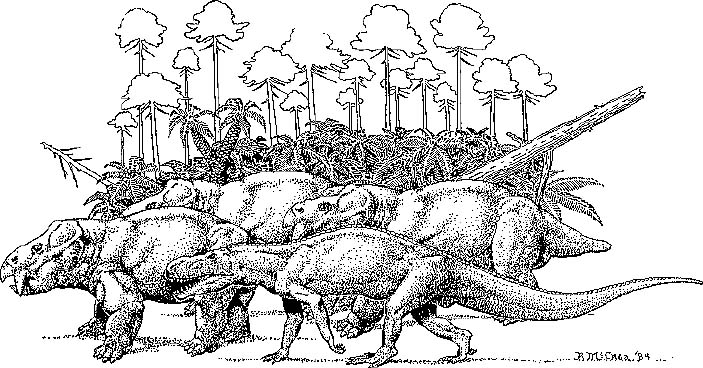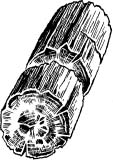US Department of the Interior
Petrified Forest National Park
Petrified Forest, AZ

| Petrified Forest | National
Park Service US Department of the Interior Petrified Forest National Park Petrified Forest, AZ |
 |
|
A Trip Through
Time |

|
 |
Let’s take a trip into the Petrified Forest National Park!
Look in our pack and make sure we are set for our journey. We have our
tent. The nights can be very cool. In winter the temperature can go below
freezing even during the day! What else do we have in our pack?
Sunblock—the summer days can be very sunny and hot. Don’t forget our rain
poncho! Even though we only get between 9 and 10 inches of rain and snow
each year, when it rains during the late summer it comes down in buckets!
Look—we are wearing sturdy boots. The ground can be rough. There are also
prickly pear and other plants with spines. But don’t hurt the plants! This
is a national park. We protect the natural environment. The Wilderness Area is a good place to explore. We may visit the Wilderness Area, but this is home to animals and plants. There are no roads or trails. There are no buildings. People are just guests! Keep your eyes open. Who knows what we will find? |
|
|
If you look carefully, you will see who else has passed this way. Whose tracks do you see? I see the deer-like hooves of a pronghorn. This horned animal is the fastest mammal in North America. They can run for a very short time up to 60 miles an hour. That is almost as fast as a car on the freeway! Whose | tracks are crossing the path? Those are the long back feet of a black-tailed jack-rabbit. They have huge ears. The long ears act as coolers and heaters. In hot weather, they stand upright and give off heat, cooling the jackrabbit; in cold weather, the ears lie back close to the body, helping to maintain body warmth. |
|
|
If we look closely, we may see other kinds of tracks. Scientists have found tracks in the rocks! They were left by large and small reptiles in sand a long time ago, even before the dinosaurs. Some tracks were left by beetles and horse-shoe crabs. More than 200 million years ago, this was a very different place. Instead of a dry grassland, this was a tropical flood-plain. Use your imagination and travel back in | time. Can you see
rivers, streams, and lakes? Can you smell the mud? A long time ago, many
animals lived among ferns and horsetails. Maybe we can see a big,
plant-eating placerias with its two tusks, peeking out from a clump of
cycads! Imagine walking up one of the streams. Mud oozes between your
toes. Logs washed down the rivers and sink into the muck.
|
 |
There is a splash!
Turning, we see a pair of eyes sticking up from the water. Is it an
alligator? No, it is a phytosaur. This meat-eater could grow as long as a
school bus! Today, we find phytosaur as fossil bones and teeth. Do you see
that purple lump in the wash? That was once part of a living, giant
reptile. Now it is a fossil. |
|
|
Trees have become fossils, too. Sinking deep into the mud of the ancient wetland, some logs didn’t rot. Volcanic ash and minerals in the water soaked into the wood. Tiny crystals grew inside all the openings in the wood. Eventually, the wood was totally gone. Only the crystals remain. Minerals |
color the wood. Red is rust, iron oxide. Blue or purple may be manganese oxide. There are many colors in the petrified wood. That is the reason we call one part of the park Rainbow Forest. Touch one of the logs. Does it feel like wood? No! It feels like stone. Petrified wood is a type of fossil. |
 |
Do you see that piece of petrified wood in the wash? What does it look like? It is an arrowhead! People have known about the Petrified Forest area for more than 10,000 years. They used the petrified wood and other stone to make their tools. About a thousand years ago, people started building homes in this region. Puerco Pueblo is a good example of homes built by the | ancestral Puebloans. It
was built of sandstone and mud about 800 years ago. If you look closely in
the plaza you might find a piece of pottery. They made pots of clay. They
also traded with their neighbors for other pots. The Ancestral Puebloans
left this area about 600 years ago. Their descendants include the Hopi and
the Zuni, who still live nearby. |
|
|
We can set up our tent now. After the sun sets, the night is
filled with thousands of stars. Have you ever seen so many stars? The air
in this area is some of the cleanest air in the country. You can fall
asleep to the sound of coyotes singing. |
people want those things for themselves. Even though it is against the law, they pick up a piece of petrified wood or a piece of old pottery and put it in their pocket. What would happen if everyone did this? Everything would be gone! Almost a million people visit the park each year. This park was set aside for everyone. We need to help protect it for when our grandchildren come to visit. Will you help? |
|
|
FAST FACTS: |

|
| August 2003 | EXPERIENCE YOUR AMERICA |
Visit our website at www.nps.gov/pefo |